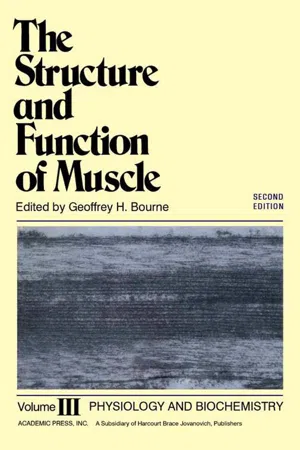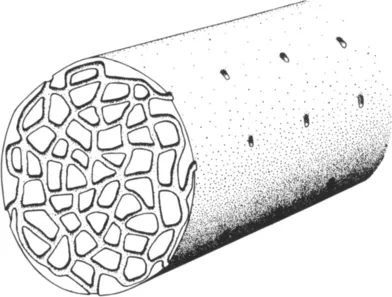
- 574 pages
- English
- ePUB (mobile friendly)
- Available on iOS & Android
Physiology and Biochemistry
About This Book
The Structure and Function of Muscle, Second Edition, Volume III: Physiology and Biochemistry presents the physiology and biochemistry of muscle. This book discusses the various aspects of the structure of muscles and explores some aspects of muscle disease.
Organized into 10 chapters, this edition begins with an overview of the transverse tubular system or T system of striated muscle. This text then examines the properties and function of membranes through electron microscopy. Other chapters consider in more detail from a biophysical viewpoint certain aspects of the series of events surrounding muscle contraction. This book discusses as well the significance of the central circulation and the amount of oxygen that can be delivered by the cardiovascular system. The final chapter deals with the heat output and chemical breakdown during an isometric twitch.
This book is a valuable resource for scientists, neurobiologists, biologists, biochemists, physiologists, histologists, cytologists, and research workers.
Frequently asked questions
Information
ELECTRICAL PROPERTIES OF THE TRANSVERSE TUBULAR SYSTEM
Publisher Summary
I Introduction
II Mathematical Analysis
A Cable Analysis as a Network

Table of contents
- Cover image
- Title page
- Table of Contents
- CONTRIBUTORS
- Copyright
- LIST OF CONTRIBUTORS
- PREFACE
- PREFACE TO THE FIRST EDITION
- CONTENTS OF OTHER VOLUMES
- Chapter 1: ELECTRICAL PROPERTIES OF THE TRANSVERSE TUBULAR SYSTEM
- Chapter 2: THE NEUROMUSCULAR JUNCTION—THE ROLE OF ACETYLCHOLINE IN EXCITABLE MEMBRANES
- Chapter 3: SOME ASPECTS OF THE BIOPHYSICS OF MUSCLE
- Chapter 4: ENERGY NEED, DELIVERY, AND UTILIZATION IN MUSCULAR EXERCISE
- Chapter 5: THE CONTROL OF MUSCULAR ACTIVITY BY THE CENTRAL NERVOUS SYSTEM
- Chapter 6: ELECTROMYOGRAPHY
- Chapter 7: PROTEINS OF THE MYOFIBRIL
- Chapter 8: BIOCHEMISTRY OF MUSCLE
- Chapter 9: BIOCHEMISTRY OF MUSCLE MITOCHONDRIA
- Chapter 10: ATP BREAKDOWN FOLLOWING ACTIVATION OF MUSCLE
- AUTHOR INDEX
- SUBJECT INDEX